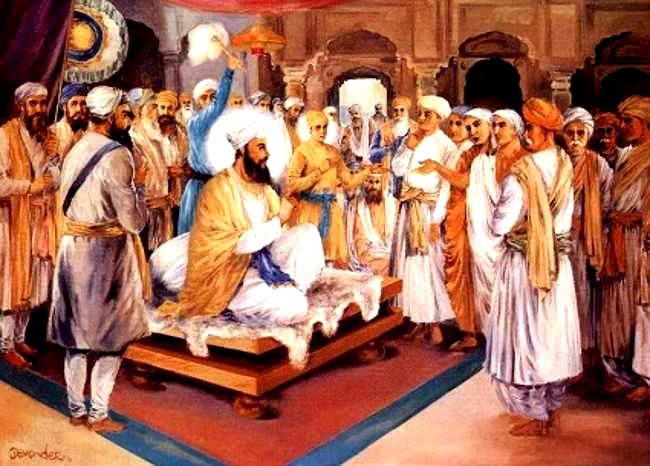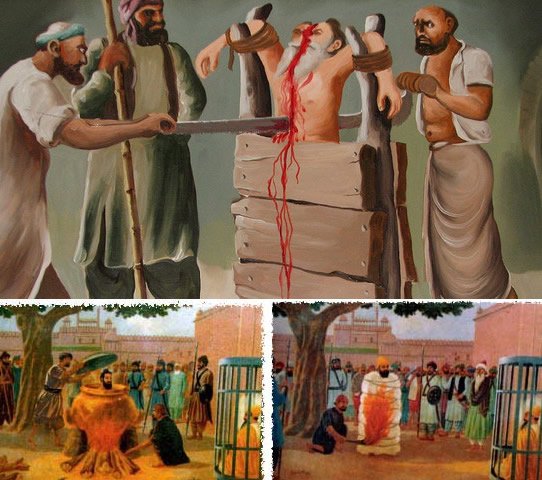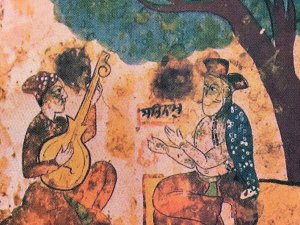Creation and destruction. We often consider these words as polar opposites. It is rare to understand that the word “creation” and the word “destruction” actually represent two phases of one process. A process of growth and evolution. And how, even on a spiritual path, people and institutions need to undergo destruction and re-creation for expansion to take place.
One of the most significant challenges in spiritual development happens when the genuine experience of a practitioner pushes the boundaries of what has already been established. And this is where destruction and re-creation become a necessary and important aspect of spiritual maturity.
The story of Guru Ram Das building and rebuilding Guru Amar Das’s throne gives an insight into this. And is a precursor for what happens to the Sikh community during the life of Guru Gobind Singh, née Gobind Rai.
Rama and Jetha
The third Guru tested both of his sons-in-law by building a platform.
▼ [Expand to Read] the story of Rama & Jetha
One important theme in this story is that Jetha did not remain attached to the throne he built. He had the capacity within his consciousness to create something, tear it down, and then recreate it. And to do this again and again and again. When we look at the spiritual path – this reflects an essential attitude. The moment we become complacent, or attached, to what the platform looks like – to how the “throne” is built – we lose flexibility, creativity, and responsibility – the ability to make a response. As our spiritual understanding evolves, our capacity to express that understanding changes, as well. And so Guru Amar Das set up a test for his sons-in-law to determine who had the most flexible, creative consciousness. Whose mind could accommodate challenge and the unexpected, and continue to rise and deliver something new – over and over again?
Headless
This drama of throne building between Guru Amar Das and Guru Ram Das actually became a much deeper issue during the life of Guru Gobind Rai. Gobind Rai was born at Patna Sahib in 1666, the son of Guru Teg Bahadur and Mata Gujri (Gujar Kaur). His mother was 42 when she gave birth to Gobind Rai. Guru Teg Bahadur was not home at the time, but travelling and teaching in Bengal and Assam.
Gobind Rai grew up with the profound stories of heroism among his forefathers. His grandfather, Guru Hargobind, initiated martial arts as part of the Sikh lifestyle. His great-grandfather, Guru Arjan, had sacrificed himself on a burning plate for five days and five nights to protect the sovereignty of the Sikh people. To protect the purity of the message in the Siri Guru Granth Sahib. These powerful examples of strength and sacrifice, in the name of Dharma, lived in Gobind Rai’s lineage.
▼ [Expland to Read] the story of Guru Teg Bahadur's martyrdom
Guru Teg Bahadur foresaw that his time of torture was soon coming to an end. His family had written to him, and in response, the great Guru composed certain Shaloks as instructions back to them. To Gobind Rai, he wrote,
“My strength is exhausted and I am in bondage. I cannot do anything at all. Says Naanak, now the Lord is my support. He will help me as he did the elephant.” (Shalok of Guru Teg Bahadur #53, Ang 1429)
To which the nine year old boy replied,
“Strength has come and all my bonds are broken. Every effort towards you starts to bear fruit. Oh God, everything is in Your hands. All my help comes from You.” (Shalok #54 0- composed by Gobind Rai. Ang 1429.)
And Guru Teg Bahadur responded,
“My friends and companions have all gone along their way. None have stayed with me to the end. In this state of seeming tragedy, I rely on You alone.” ( Shalok of Guru Teg Bahadur #55, Ang 1429)
In this exchange, Guru Teg Bahadur knew that his son, though very young, had the consciousness to assume the responsibility for the Guruship.
In the meantime, Aurangzeb was growing impatient with Guru Teg Bahadur’s refusal to accept Islam. So he sent a Muslim priest and a nobleman of the court to the Guru with one final request.
“Accept Islam or work a miracle. If you work a miracle, you may remain the Guru that you are. If you accept Islam, I will put you in an exalted position and you will be happy. If you do not accept either of these terms then you will be put to death.”
Guru Teg Bahadur remained as steadfast as ever. He replied, “ I will never abandon my faith. I want no honor in this life. I wish for honor hereafter. The threat of death does not scare me since one day I will leave this perishable body anyway. I am prepared to die and cheerfully accept it.”
When Aurangzeb heard this message, he became enraged at the Guru’s response.
Aurangzeb ordered the beheading of Guru Teg Bahadur in the market in Delhi. But what most people do not realize is the impact that this had on the nine year old Gobind Rai. Because while Guru Teg Bahadur had the bravery to sacrifice his head and his life to protect the fundamental message of the Sikh faith – which is to respect the Light of the Divine in everyone, in everything, and in all paths – the Sikhs, themselves, became afraid. They hid themselves and did not claim allegiance to Guru Teg Bahadur during the execution.
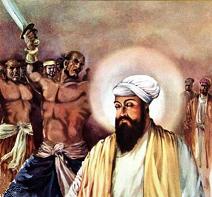 Saiyid Adam Shah served as the executioner. The Guru sat beneath a banyan-tree and recited Guru Nanak’s Japji Sahib and the Guru asked Adam Shah to take his sword and strike his neck when he bowed at the conclusion of his prayers. The executioner did as he was told. And Guru Teg Bahadur’s head immediately flew into the lap of a Sikh, who had come as a messenger from Anandpur Sahib.
Saiyid Adam Shah served as the executioner. The Guru sat beneath a banyan-tree and recited Guru Nanak’s Japji Sahib and the Guru asked Adam Shah to take his sword and strike his neck when he bowed at the conclusion of his prayers. The executioner did as he was told. And Guru Teg Bahadur’s head immediately flew into the lap of a Sikh, who had come as a messenger from Anandpur Sahib.
Outside of this one Sikh, the other Sikhs hid themselves and the corpse of Guru Teg Bahadur’s body was left in the market, unclaimed, until a group of Sikhs from the Labana tribe, ashamed at the way the Guru’s body had been left, brought an oxen cart to the market loaded with sacks. When a dust storm arose to give them cover, these Sikhs took the Guru’s body and hid it among the sacks of the cart. They then took the corpse back to their village where they burned all of their houses as a cremation ground for the Guru’s body.
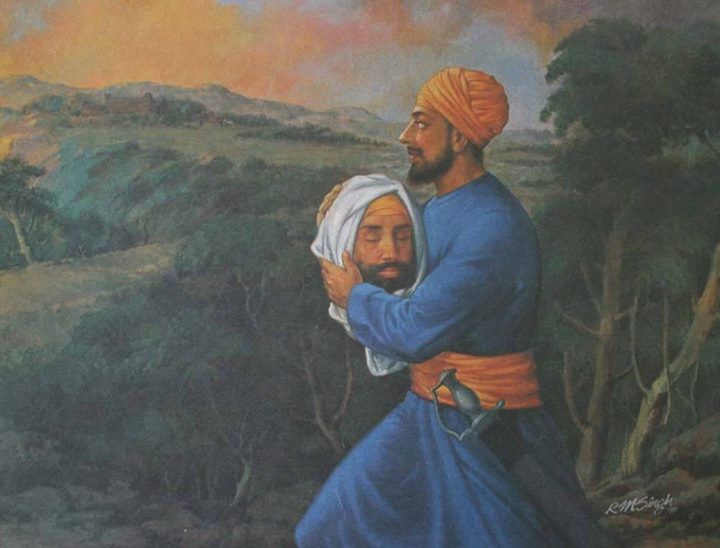
In the meantime, the servant from Anandpur Sahib returned to Gobind Rai with the head of his father, Guru Teg Bahadur. The servant shared with the nine year old Guru how the Sikhs had distanced themselves from their Guru during the execution.
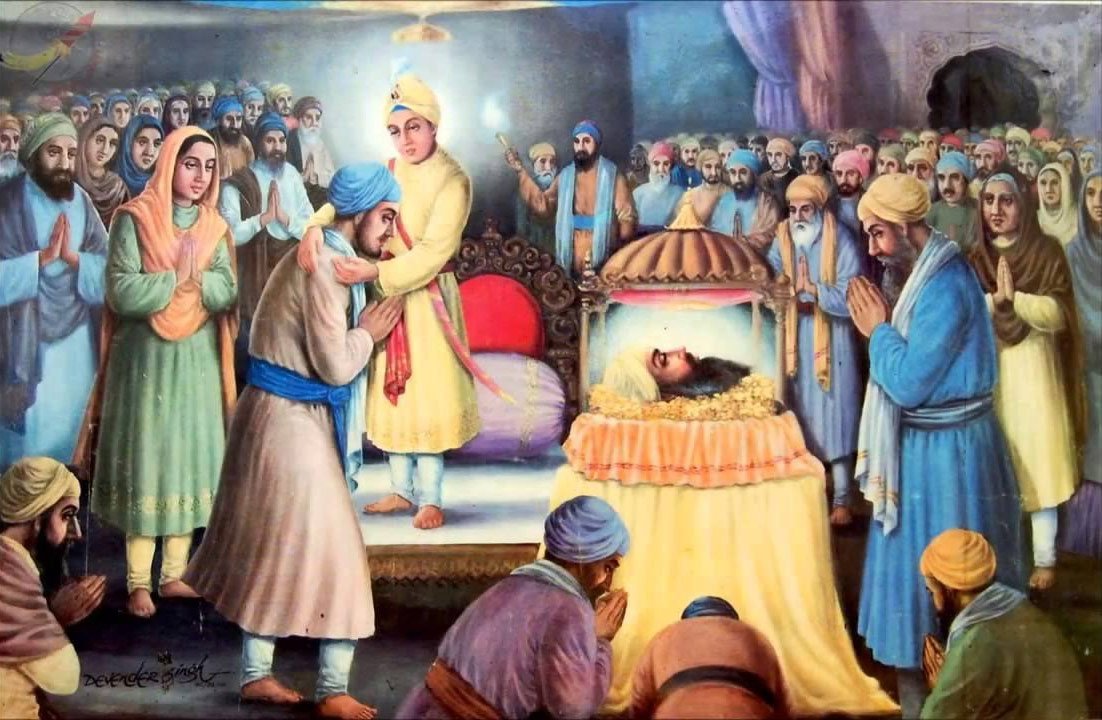
We like to think of the Gurus as somehow greater than human rather than subject to the same emotional processes that we go through. But when we look at history, and peer into Gobind Rai’s future, there is no question this moment left an indelible mark upon the young Guru. In his innocence, he had grown up with stories of profound valor from his ancestors. When his father sacrificed his life to protect freedom of religion, Gobind Rai might just have seen that as a continuation of what his family had done for generations.
Yet, it is recorded that Gobind Rai reacted strongly when he heard that no Sikh had the courage to stand and be recognized during his father’s execution. That instead, the Sikhs hid and no one immediately came forward to claim Guru Teg Bahadur’s body.
We need to remember that there had been a continuous line of human Gurus, unbroken from around 1500 when Guru Nanak had his enlightenment experience until November 24, 1675 when Guru Teg Bahadur sacrificed his head for the protection of all faiths. This is a span of 175 years. In 175 years of continuous teaching and leadership, the Sikhs had failed, in that moment, to have the strength to risk their lives for the Guru and for the teachings.
175 years is no small amount of time.
So this young Guru, at nine years old, had only the head of his own father, Guru Teg Bahadur, to perform last rites with. He had a head and nothing else. And meditating upon that head, meditating upon the incredible sacrifice of his father - knowing that after 175 years, the Sikhs did not have the strength or the courage to stand up and bear witness to their own Guru during this extreme test - all of that must have gone through Gobind Rai’s mind over and over again.
Like Guru Ram Das who had to be unattached to the way he had built Guru Amar Das’s throne, to be willing to tear it down and rebuild it, Gobind Rai had a huge test ahead of him during his Guruship. He had to figure out a way to simultaneously destroy the Sikh identity that had existed, and resurrect it so that the Sikhs would have a spirit so fearless, they could defend their traditions and face death with a smile.
This beheading of Guru Teg Bahadur and the impression it left on the nine year old boy Guru is the true seed of Baisakhi. And understanding the process of tearing down and rebuilding is an essential lesson of how the Sikh faith developed.
In reality, there were two Guruships during Guru Gobind Rai/Gobind Singh’s life. There was the Guruship of Guru Gobind Rai - the young boy who had to assume the throne at age 9. Who had to cremate with ceremony and prayer, the head of his own father. Who married Mata Jito ji; who taught; who wrote Jaap Sahib at age 19; who chose to build his own war drum and have it played to establish his territory as separate from the Moghul Empire and the nearby Rajas of the hills; who dealt with the jealousy of others when great gifts like a white elephant were given to him.
The Guruship of Gobind Rai is one piece of history... one throne. And we do not necessarily pay enough attention to it.
But on Baisakhi of 1699, in the most profound method possible, Gobind Rai tore down his own throne. Tore down his position as “the Guru.” He tore apart everything that had existed for over 200 years. And he asked for a head. Guru Gobind Rai asked for a Sikh who would be willing to blindly sacrifice his head, the way his father, Guru Teg Bahadur, had sacrificed his. And once Gobind Rai started down that path, there was no going back.
By the time the ceremony was complete, five brave Sikhs had stepped forward to offer their heads: Bhai Daya Singh, Bhai Dharam Singh, Bhai Himmat Singh, Bhai Muhkam Singh and Bhai Sahib Singh. And Gobind Rai willingly GAVE UP his Guruship and became the student of these five Sikhs. He renamed himself Gobind Singh to show his brotherhood with his Beloved Ones, those who would seed an entire new manifestation of the Sikh faith which blossomed from the seeds of self-sacrifice, of fearlessness and of embracing death through love. Guru Gobind Rai went through his own death and rebirth during Baisakhi in order to build a new throne capable of resisting the Moghul Empire; capable of surviving on horseback in the jungle; capable of victory in military battle against unbelievable odds. And the legacy continued for centuries - with stories of the amazing feats of the Sikh warriors during World Wars 1 and 2.
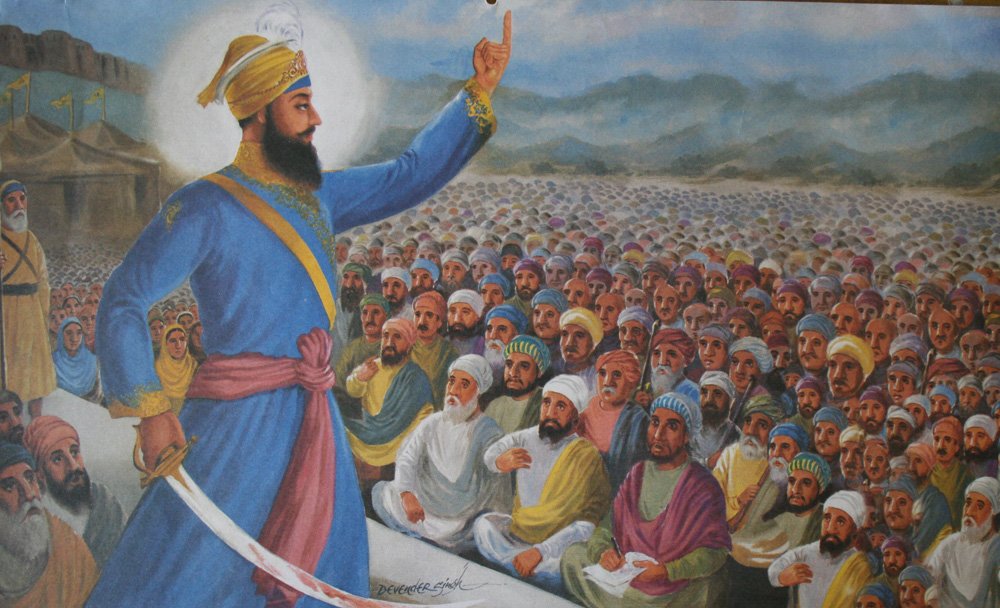
This week, when we honor the birth anniversary of Guru Gobind Rai/Gobind Singh - many people will focus on the formation of the Khalsa, and the Siri Guru Granth Sahib being established as the Sikh’s eternal Guru.
But for today, I wanted to honor and remember the nine year old boy, who had so much faith, courage and heart, and who had to face the tragedy of his own father’s beheading. And how that nine year old would one day find the strength to tear down and rebuild the Sikh faith - so that fearless courage could live in our hearts forever.
Wahe Guru Ji Ka Khalsa, Wahe Guru Ji Ki Fateh.
With Divine Light,
Ek Ong Kaar kaur
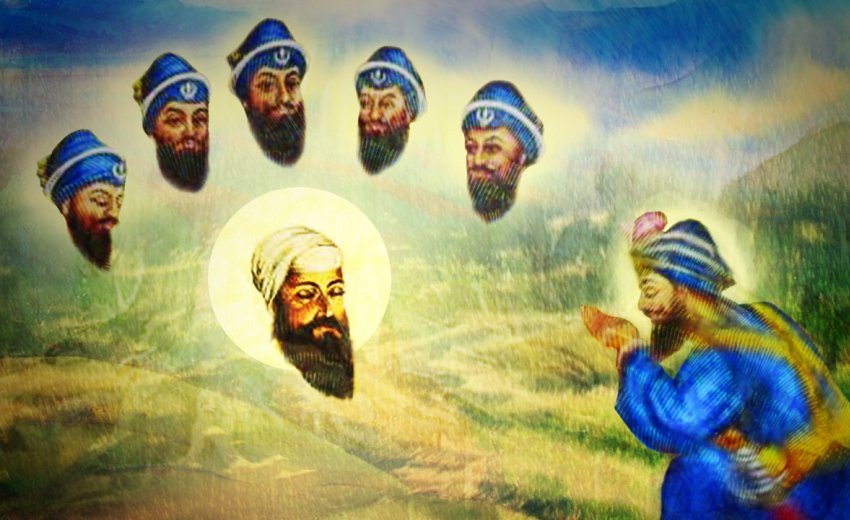

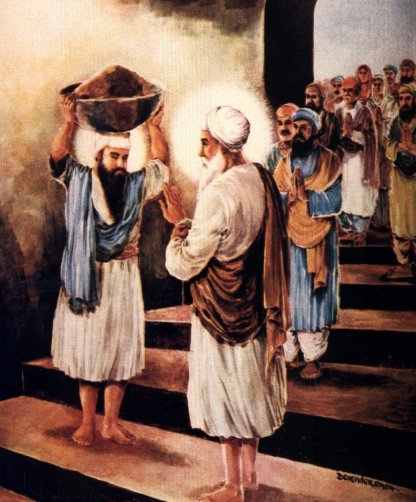 The second day came and went much like the first. Both Jetha and Rama applied themselves with even more energy and effort to building the Guru’s throne. As the second day came to a close, Guru Amar Das still seemed deeply displeased. He could find nothing good to say about either of the thrones, explained what exactly was wrong with each of them and then said, “Tear them down and build them again.”
The second day came and went much like the first. Both Jetha and Rama applied themselves with even more energy and effort to building the Guru’s throne. As the second day came to a close, Guru Amar Das still seemed deeply displeased. He could find nothing good to say about either of the thrones, explained what exactly was wrong with each of them and then said, “Tear them down and build them again.”